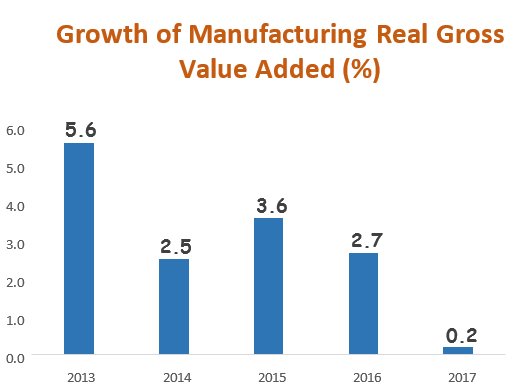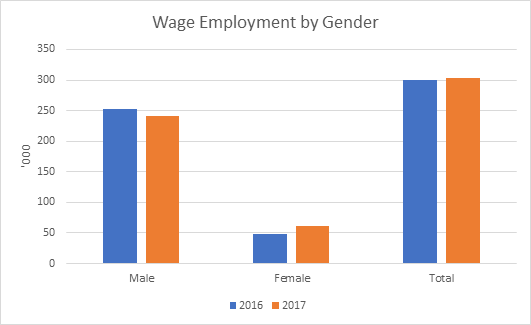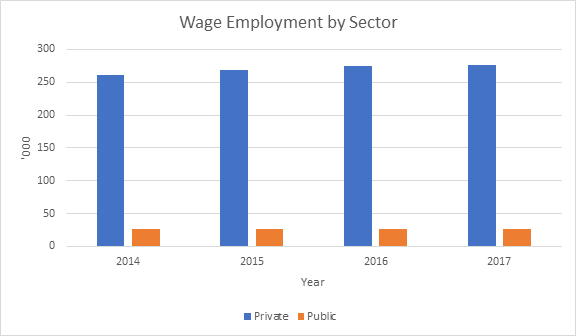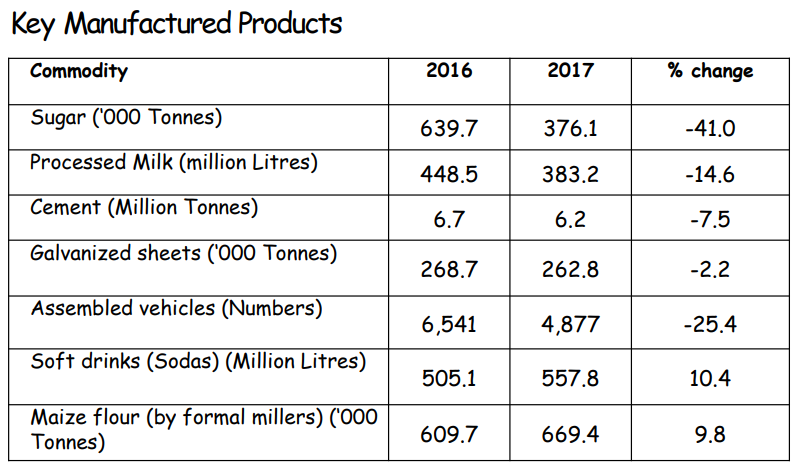Manufacturing stands tall as a key pillar in the Big Four development agenda by the National Government. Manufacturing is seen to be the key to unlocking the success of the other development goals, namely: Universal Healthcare, Affordable Housing and Food Security. The argument is that manufacturing will create many quality jobs thereby improving the living standards of the workers, elevating them to access proper healthcare and decent affordable housing. The Government has set up numerous development projects in the manufacturing sector that seeks to raise the share of manufacturing in the gross domestic product (GDP) from the current 10% to 15% by 2022.
However, the manufacturing industry in Kenya has been sluggish over the years. The high cost of electricity has been a huge hindrance in the manufacturing sector. Also, increased competition from the cheaper ‘Made in China’ goods has made it difficult for locally manufactured products to be super profitable.
The following diagram shows the contribution of the Manufacturing sector to the GDP over the years.

The contribution of the Manufacturing sector towards the GDP has been erratic over the years. The most recent peak was in 2011 where the contribution reached a high of 13% but dipped to 10% in 2016.
The 2018 KNBS Economic Report shows that in 2017 the manufacturing sector real value added grew by a mere 0.2% compared to the 2.7% growth in 2016.This has been attributed to the prolonged electioneering period, where the general economy was slow.

According to the KNBS 2018 Economic Report, the manufacturing sector occupies the third largest share of wage employment by activity at 11.4%, after Education at 20.7% and Agriculture, forestry and fishing at 12.5%. The same report also highlights the level of wage employment in Manufacturing, by Gender and by Public vs Private sector, as illustrated below.

The number of male employees decreased while that of female employees in manufacturing increased. This saw an overall slight increase in the total wage employees in the manufacturing sector.

Wage employment in the private sector has been steadily rising over the years while in the public sector, the wage employment has remained stagnant.
The proposed developments in the Big Four Agenda for the Manufacturing sector seek to create over 1.3 million jobs in manufacturing alone by 2022.
The following table shows the key manufactured products in Kenya and makes a comparison in production between the years 2016 and 2017:

The volume of output of the sector contracted by 1.1 per cent attributed mainly to decline in food products, beverages and tobacco, leather and related products, rubber and plastics and non-metallic minerals sub-sectors.
What exactly is stipulated in the Big Four Agenda for Manufacturing?
- A modern industrial park in Naivasha, apparel industrial sheds in Athi River, the establishment of the Dongo Kundu special economic zone (SEZ) and rollout of genetically modified cotton.
- For leather, the Machakos leather park will be completed, and train 5,000 cottage industries, change policies to stop imports of finished leather and identify three other industrial parks along the SGR.
- To accelerate the export of agro-processed products by mapping tea, dairy, meat, and crop value chains. They will attract two global tea processors to Mombasa, regulate milk hawking, develop warehousing and cold chains and make Mombasa a food value hub and all these could create 200,000 jobs.
- Also, the manufacturing of construction materials could create 10,000 new jobs when combined with a “buy Kenya” policy that targets 70 per cent of housing material.
- In oil and mining, the plan is to attract one global mining player and export Turkana oil.
- In iron and steel, the hope is to attract $1 billion in new investments and establish coal and iron deposits.
- In ICT, they hope to assemble phones, TV’s and laptops, and have 5 BPO players, an IT entrepreneurs programme and an innovation ecosystem of incubators and accelerators which could create 10,000 jobs.
- For fish processing, a $20 million fish feed mill, a blue ocean policy and an aquaculture special economic zone on Lake Victoria, which could see Kenya’s fish exports grow from 2,500 tons annually to 18,000 tons and this should create 20,000 jobs.
Wow! The future sure looks bright for the Manufacturing industry.
Will this huge push for Manufacturing finally see the manufacturing industry reach its peak potential?
I guess, only time will tell.
